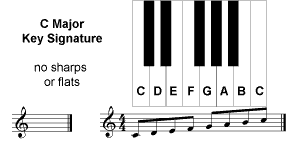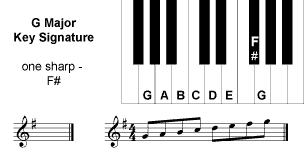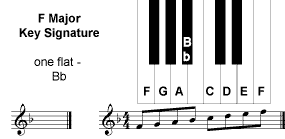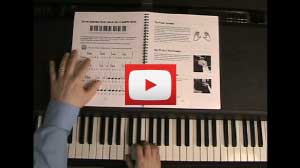More About Key Signatures:
Sharps, Flats and Naturals
Before we get into key signatures, we should know what sharps, flats and naturals are. Sharps, flats and naturals are collectively called "accidentals."
Accidental signs are placed before the note affected on the written music. But - they are described with the note name first, and then the accidental. For example, the black key to the right of C could be called "C Sharp."
Accidentals are good for the rest of the measure they appear in, meaning if a note has a sharp, flat or natural sign in front of it, it stays that way until the next barline. The barline cancels accidentals.

The sharp sign looks like a "number" sign, "hashtag" or "pound" sign on the telephone. A sharp raises a note one half step, to the key immediately to its' right, whether black or white. For example, a C note with a sharp sign in front of it would be played on the black key to its immediate right.
The flat sign looks like a lower case letter b. A flat sign lowers a note one half step to the key immediately to its left, whether black or white. For example, a B note with a flat sign in front of it would be played on the black key to its' immediate left.
The natural sign looks similar to, but is not to be confused with the sharp sign. The natural sign cancels a sharp or flat, which means it returns the note to its white key position on the keyboard.
Key Signatures
A key signature is the sharp(s) or flat(s)at the beginning of a piece of music, after the clef sign, and before the time signature.
This tells us two things:
1. What note(s), if any, are sharp or flat in the piece of music,
2.The tonal "center" or scale of the piece of music.
Some Examples:

The key of C Major has no sharps or flats in its scale. So the key of C looks like it has no "signature." This "key signature" tells us that the music is based on the C scale, which is all of the white keys (no sharps or flats) played from C to C.

The signature for G Major has one note, F, that is sharp. This tells us to play all F notes as F sharp, unless the F has a natural sign in front of it.

The key of F Major has one flat, B. This tells us that all Bs are flat unless they are preceded by a natural sign.
Sharp Key Signatures

The sharps in a key signature always follow the same order. From left to right: F#, C#, G#, D#, A#, E#, and B#. They are always written in the line or space as shown above.
Sharp Keys - Major and relative minor (same signature)
G Major / E Minor = 1 sharp: F#
D Major / B Minor = 2 sharps: F#, C#
A Major / F# Minor = 3 sharps: F#, C#, G#
E Major / C# Minor = 4 sharps: F#, C#, G#, D#
B Major / G# Minor = 5 sharps: F#, C#, G#, D#, A#
F# Major / D# Minor = 6 sharps: F#, C#, G#, D#, A#, E#
C# Major / A# Minor = 7 sharps: F#, C#, G#, D#, A#, E#, B#
Flat Key Signatures

The flats in a key signature also always follow the same order. From left to right: Bb, Eb, Ab, Db, Gb, Cb, and Fb. They are always written in the line or space as shown above.
Flat Keys - Major and relative minor (same signature)
F Major / D Minor = 1 flat: Bb
Bb Major / G Minor = 2 flats: Bb, Eb
Eb Major / G Minor = 3 flats: Bb, Eb, Ab
Ab Major / F Minor = 4 flats: Bb, Eb, Ab, Db
Db Major / Bb Minor = 5 flats: Bb, Eb, Ab, Db, Gb
Gb Major / Eb Minor = 6 flats: Bb, Eb, Ab, Db, Gb, Cb
Cb Major / Eb Minor = 7 flats: Bb, Eb, Ab, Db, Gb, Cb, Fb
Start Playing Piano Today with the Piano Guide Quick Start Course!
Easy to follow step-by-step lessons designed for adult beginners. The next best thing to private lessons!
What You'll Learn:
- Notes on the piano/keyboard
- Proper fingering
- C major scale
- Chords
- How to read music
- And much more!

Video lessons - watch as I play everything for you.

